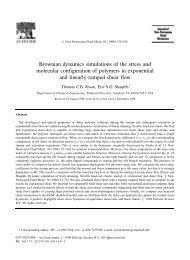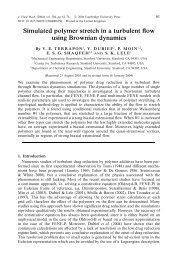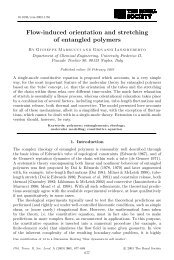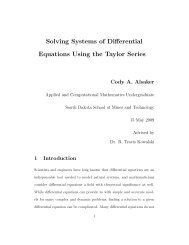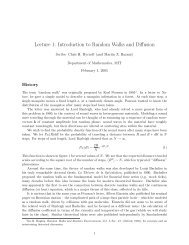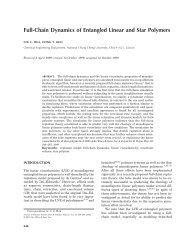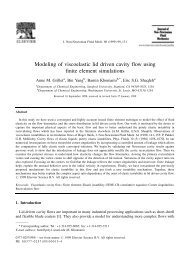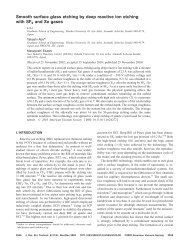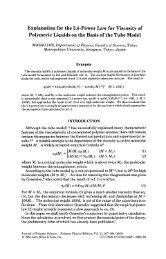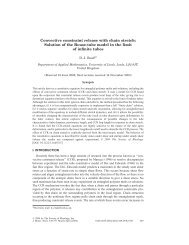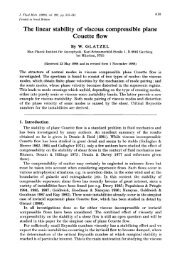A numerical study of the rheological properties of suspensions of ...
A numerical study of the rheological properties of suspensions of ...
A numerical study of the rheological properties of suspensions of ...
You also want an ePaper? Increase the reach of your titles
YUMPU automatically turns print PDFs into web optimized ePapers that Google loves.
156fibre suspension can be writtenM. B. Mackaplow and E. S. G. Shaqfeh(8) = 2,u (e) + n (s) (1)where ,u is <strong>the</strong> viscosity <strong>of</strong> <strong>the</strong> suspending fluid, e is <strong>the</strong> volume-averaged fluid rate <strong>of</strong>strain tensor, n is <strong>the</strong> particle number density, and (S) is <strong>the</strong> average particle ‘stresslet’.The latter is a symmetric, traceless tensor that is a function <strong>of</strong> particle shapes, sizes,orientations, and centre-<strong>of</strong>-mass distributions. It will be discussed in more detail in$2. In general, for orientable particles, (S) will not have <strong>the</strong> same tensorial form as(e). Therefore, <strong>the</strong> volume-averaged deviatoric stress tensor <strong>of</strong> <strong>the</strong> suspension cannotbe written merely as 2peff(e), where ,ueff is referred to as <strong>the</strong> effective viscosity <strong>of</strong> <strong>the</strong>suspension.In addition, <strong>the</strong> <strong>rheological</strong> <strong>properties</strong> <strong>of</strong> fibre <strong>suspensions</strong> may change dramaticallyduring startup. This is because <strong>the</strong> instantaneous suspension <strong>properties</strong> are a strongfunction <strong>of</strong> <strong>the</strong> fibre orientation distribution. The orientation distribution evolvesover time as particles rotate in <strong>the</strong> mean flow and interact with each o<strong>the</strong>r until asteady-state distribution is reached. This has been observed experimentally by Bibbo(1987). In industrial applications, such as <strong>the</strong> injection moulding <strong>of</strong> <strong>suspensions</strong>, it ispossible that <strong>the</strong> suspension will experience a rapidly changing flow field such thata steady-state orientation distribution will never be reached. Thus, it is importantto understand both <strong>the</strong> development <strong>of</strong> <strong>the</strong> orientation distribution and how <strong>the</strong><strong>rheological</strong> <strong>properties</strong> vary as a function <strong>of</strong> it. We note that <strong>the</strong> effect <strong>of</strong> <strong>the</strong> particleorientation distribution on <strong>the</strong> <strong>rheological</strong> <strong>properties</strong> <strong>of</strong> <strong>the</strong> suspension is particularlyimportant for large particle aspect ratios, as indicated by equation (11) below.The reason that small volume fractions <strong>of</strong> fibres can have such large effects on<strong>the</strong> <strong>rheological</strong> <strong>properties</strong> <strong>of</strong> a suspension can be understood by examining <strong>the</strong><strong>the</strong>oretical results <strong>of</strong> Batchelor (1970) for isolated fibres, henceforth referred to as<strong>the</strong> dilute <strong>the</strong>ory. These show that <strong>the</strong> disturbance to <strong>the</strong> flow field created by a fibre<strong>of</strong> aspect ratio A is only llln(2A) weaker than a sphere having <strong>the</strong> same diameteras <strong>the</strong> fibre length. Moreover, <strong>the</strong> disturbance extends over <strong>the</strong> same fluid volume.Thus, <strong>the</strong> disturbance per unit particle volume created by a fibre relative to that <strong>of</strong> asphere is O(A*/ln(A)), which can be quite large even with fibres <strong>of</strong> moderate aspectratio. However, only <strong>the</strong> governing equations for <strong>suspensions</strong> where <strong>the</strong> fibres arenot interacting with each o<strong>the</strong>r are analytically tractable. Since, as shown by <strong>the</strong>dilute <strong>the</strong>ory, <strong>the</strong> interaction length <strong>of</strong> a fibre is determined by its physical length,21, fibre interactions can only be neglected when n13



